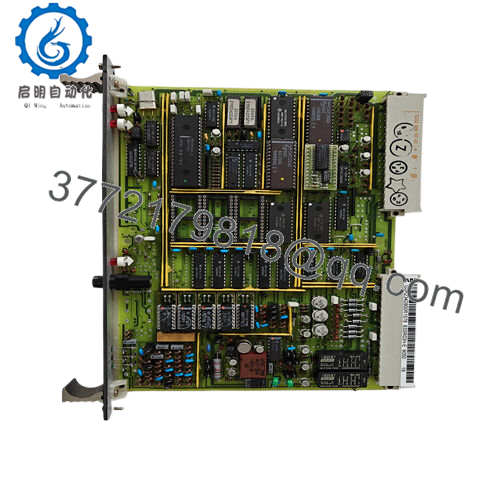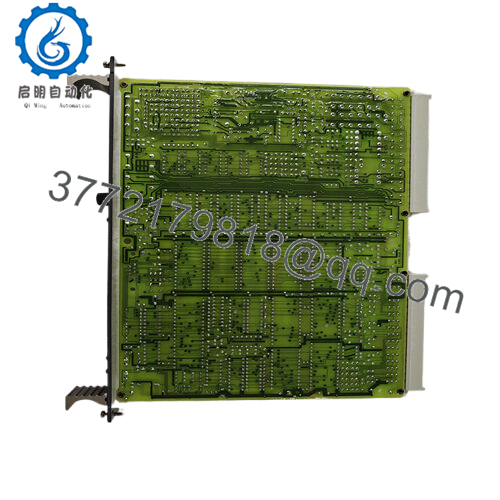Description
ABB 83SR03H-E GJR2342800R1578 – Compact Signal Relay Module with Proven Reliability
Back in 2018, I was part of a refinery upgrade project in Qatar where we had to keep the legacy ABB INFI 90 system running while integrating a new batch of process control equipment. One of the modules that refused to die — even after decades of heat, dust, and power fluctuations — was the ABB 83SR03H-E (GJR2342800R1578). These relay modules are the unsung heroes of the system. They don’t have fancy processors or communication ports, but without them, the entire chain of control falls apart.

83SR03H-E GJR2342800R1578

83SR03H-E GJR2342800R1578
Technical Specifications
Here’s a closer look at what the 83SR03H-E brings to the table:
| Parameter | Specification |
|---|---|
| Model | 83SR03H-E |
| ABB Code | GJR2342800R1578 |
| Function | 4-channel signal relay module |
| Contact Type | Form C (SPDT) |
| Coil Voltage | 24 VDC nominal |
| Contact Rating | 2A @ 30VDC / 250VAC |
| Isolation Voltage | 1500V between coil and contacts |
| Power Consumption | Approx. 2.5W |
| Response Time | < 10 ms typical |
| Indicators | LED per relay for state indication |
| Mounting | Plug-in module for ABB INFI 90 rack |
| Operating Temperature | 0°C – 60°C |
Real-world Experience in the Field
I still remember a case where three 83SR03H-E units were running in a sulfur recovery unit’s control rack. We had intermittent output loss alarms on one controller, and everyone suspected software or wiring. Turned out, it was simply one relay contact worn down after nearly a million cycles. We replaced the module, and boom — the output came back instantly. What struck me was how clean the relay performance was after replacement — no contact bounce, no lag, just crisp switching.
That’s the thing with the 83SR03H-E: when it works, you barely know it’s there. And when it fails, it’s easy to pinpoint. ABB really thought through the field serviceability of this series.
What’s important is how ABB optimized these relays for long-term signal integrity. Even under high switching loads or noisy environments, they maintain solid isolation and consistent contact resistance.
Performance & Reliability Notes
Now here’s what’s funny — I’ve seen some of these modules outlive their controllers. Seriously. You can have an old ABB controller board go faulty, and yet the 83SR03H-E modules are still sitting there, LEDs flickering faithfully. ABB’s relay technology from this generation is legendary for mechanical endurance and insulation reliability.
However, I’ll admit one gripe: the relay removal requires steady hands. The backplane pins can be a little tight, so if you’re pulling modules out during a shutdown, take it slow. One technician in Brazil once cracked the edge connector by rushing it — we learned the hard way that patience saves money.
Comparison & Applications
Compared to the 83SR04, this 83SR03H-E is slightly more compact and optimized for lighter I/O switching tasks. You’ll find it commonly used in:
- Distributed Control Systems (DCS) output relay racks
- Interfacing between logic controllers and field actuators
- Power plant alarm panels and turbine control systems
- Refineries and chemical plants with ABB INFI 90 infrastructure
- Safety interlock feedback circuits
If you’re working on a mixed system that still uses ABB Bailey or INFI 90 modules, the 83SR03H-E fits right in without compatibility issues.
Maintenance & Replacement Tips
A few things I’ve learned over the years:
- Label everything — these relays often sit in tight racks with identical modules, and it’s easy to swap them by mistake.
- Check relay chatter — if the LED flickers inconsistently under stable signals, it’s often a grounding issue, not a failed relay.
- Avoid hot-swapping unless your rack supports it — ABB documentation isn’t kidding about transient surge risk.
- Always store replacements in anti-static foam and dust-free containers.
A quick continuity test during preventive maintenance can save you a lot of downtime.
Detailed Technical Specifications
| Parameter | Value |
|---|---|
| Model | 83SR03H-E GJR2342800R1578 |
| Brand | ABB |
| Type | Binary Input Module |
| Power Supply | 24 V DC |
| Operating Temperature | -10°C to +60°C |
| Mounting | SR Series Backplane (Eurocard) |
| Dimensions | 160 mm x 100 mm x 20 mm |
| Weight | 0.35 kg |
| Interfaces | 8x Isolated Binary Inputs, Internal Bus |
| Certifications | CE, IEC 61508 SIL 2, EN 50178 |
| Cooling | Natural Convection |
| Environmental Rating | IP20 (Conformal Coated) |
Related Modules or Compatible Units
83SR04 GJR2390200R1211 – Quad binary output companion that acts on signals from the 83SR03H-E GJR2342800R1578 for trip relay driving in boiler interlocks. 83SR50C-E GJR2395500R1210 – Multi-function processor unit, orchestrates logic from the 83SR03H-E GJR2342800R1578 in full SR protection chains. 83SR05E GJR2369900R1100 – Analog input variant, extends sensing alongside the 83SR03H-E GJR2342800R1578 for hybrid binary/analog furnace monitoring. SD833 3BSE008103R1 – Redundant power supply, feeds stable rails to the 83SR03H-E GJR2342800R1578 in duplex SR racks for high-availability. INNIS11 – Network interface for Cnet, routes events from the 83SR03H-E GJR2342800R1578 to Symphony Plus for centralized alarming. PM866K01 3BSE050198R1 – AC 800M processor, integrates binary data from the 83SR03H-E GJR2342800R1578 in 800xA migrations. INSEM01 – SOE master module, timestamps inputs from the 83SR03H-E GJR2342800R1578 for detailed event sequencing in DCS.
Installation Notes & Maintenance Best Practices
Slotting the 83SR03H-E GJR2342800R1578 into an SR backplane requires a bus scan first—power down the station and verify no shorts with a 100Ω pull-up on inputs, as floating lines have induced chatter in humid biomass plants; align pins with ESD tweezers, seating until latches snap, then torque ribbon connectors to 0.4 Nm. In vibey turbine halls, secure with nylon washers to counter 1g shakes, routing 1 mm² twisted pairs in grounded trays—skip ferrites on short runs under 10 m, but clamp for longer hauls in EMI-saturated refineries. Pre-configure debounce via Symphony offline, testing with a pulse generator at 5 Hz to confirm 2 ms edges without misses; offsets flag wiring capacitance, trimmed by shortening stubs below 50 m.
Sustain the 83SR03H-E GJR2342800R1578 with quarterly channel probes using a 24V source; resistances over 1 kΩ signal contact oxidation, cleaned with 90% iso under domes in clean boiler bays. ABB’s diagnostics suite dumps event queues monthly—hunt for debounce overruns above 1%, adjustable in firmware without pulls. For dusty outback stations, vacuum slots bi-annually with anti-static brushes, sequencing offline to dodge live faults, and exercise isolators yearly with a hi-pot at 2000V; it’s uncovered latent breakdowns before they bit. Log input baselines post-commission against temp cycles, tweaking wetting to 3 mA for marginal sensors—these steps seal a 12-year vigil without voids.

 WhatsApp: +86 16626708626
WhatsApp: +86 16626708626 Email:
Email:  Phone: +86 16626708626
Phone: +86 16626708626


